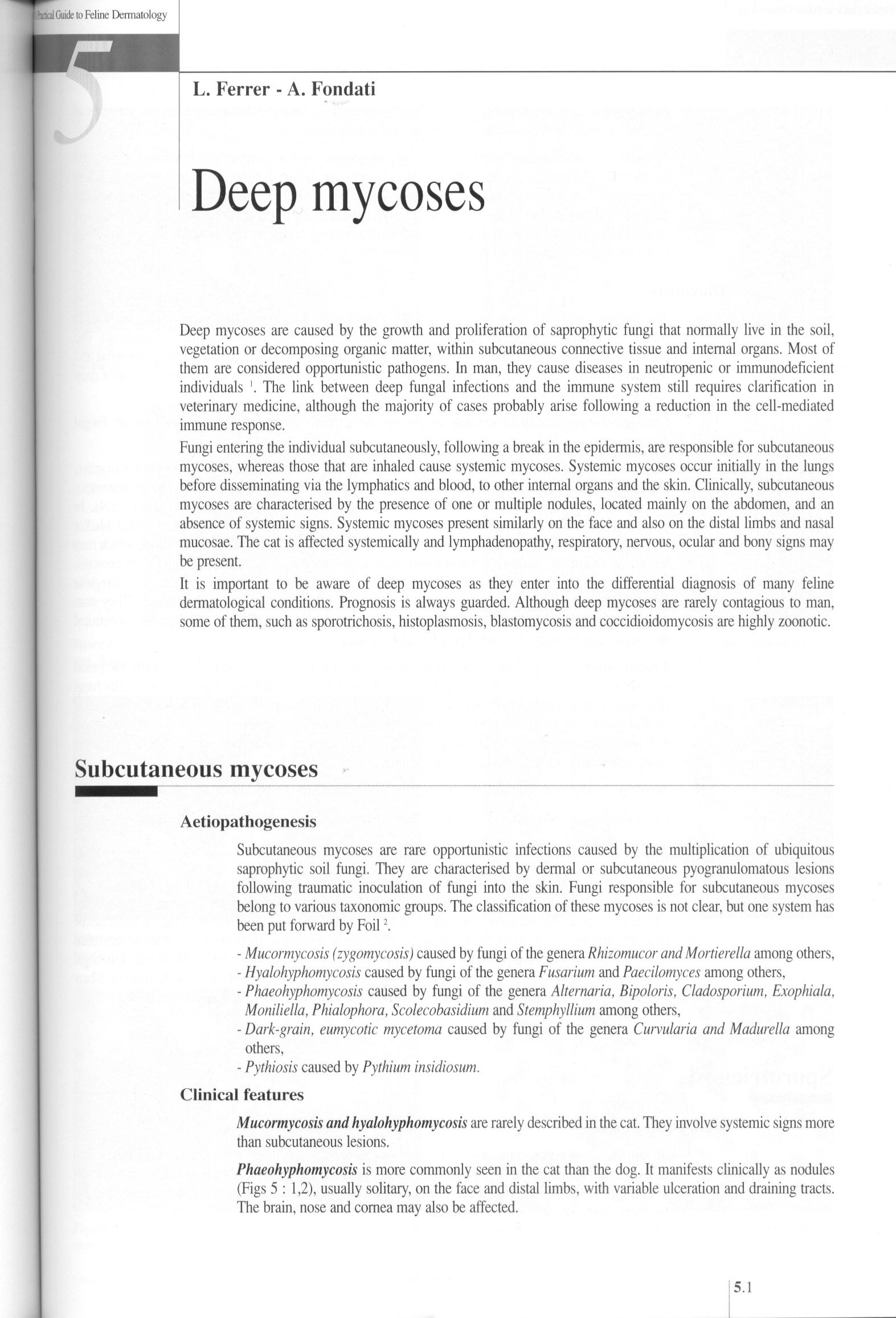51 (177)

Guide to Feline Dermatology
L. Ferrer - A. Fondati
Deep mycoses
Deep mycoses are caused by the growth and proliferation of saprophytic fungi that normally live in the soil, vegetation or decomposing organie matter, within subcutaneous connective tissue and intemal organs. Most of them are considered opportunistic pathogens. In man, they cause diseases in neutropenic or immunodeficient individuals The link between deep fungal infections and the immune system still requires clarification in veterinary medicine, although the majority of cases probably arise following a reduction in the cell-mediated immune response.
Fungi entering the individual subcutaneously, following a break in the epidermis, are responsible for subcutaneous mycoses, whereas those that are inhaled cause systemie mycoses. Systemie mycoses occur initially in the lungs before disseminating via the lymphatics and blood, to other intemal organs and the skin. Clinically, subcutaneous mycoses are characterised by the presence of one or multiple nodules, located mainly on the abdomen, and an absence of systemie signs. Systemie mycoses present similarly on the face and also on the distal limbs and nasal mucosae. The cat is affected systemically and lymphadenopathy, respiratory, nervous, ocular and bony signs may be present.
It is important to be aware of deep mycoses as they enter into the differential diagnosis of many feline dermatological conditions. Prognosis is always guarded. Although deep mycoses are rarely contagious to man, some of them, such as sporotrichosis, histoplasmosis, blastomycosis and coccidioidomycosis are highly zoonotic.
Subcutaneous mycoses
Aetiopathogenesis
Subcutaneous mycoses are rare opportunistic infections caused by the multiplication of ubiąuitous saprophytic soil fungi. They are characterised by dermal or subcutaneous pyogranulomatous lesions following traumatic inoculation of fungi into the skin. Fungi responsible for subcutaneous mycoses belong to various taxonomic groups. The classification of these mycoses is not elear, but one system has been put forward by Foil2.
- Mucormycosis (zygomycosis) caused by fungi of the genera Rhizomucor and Mortierella among others,
- Hyalohyphomycosis caused by fungi of the genera Fusarium and Paecilomyces among others,
- Phaeohyphomycosis caused by fungi of the genera Alternaria, Bipoloris, Cładosporium, Exophiala, Moniliella, Phialophora, Scolecobasidium and Stemphyllium among others,
- Dark-grain, eumycotic mycetoma caused by fungi of the genera Cwyularia and Madurella among others,
- Pythiosis caused by Pythium insidiosum.
Clinical features
Mucormycosis and hyalohyphomycosis are rarely described in the cat. They involve systemie signs morę than subcutaneous lesions.
Phaeohyphomycosis is morę commonly seen in the cat than the dog. It manifests clinically as nodules (Figs 5 : 1,2), usually solitary, on the face and distal limbs, with variable uleeration and draining traets. The brain, nose and comea may also be affected.
i 5.1
Wyszukiwarka
Podobne podstrony:
46 (213) 4 A Practical Guide to Feline Dermatology from cats with untreated infections are often pos
58 (148) 5 A Practical Guide to Feline Dermatology severity of the illness. High titres are seen wit
65 (127) 6 A Practical Guide to Feline Dermatology Other topical antimicrobial agents, such as chlor
67 (125) 6 A Practical Guide to Feline DermatologyNocardiosisAetiopathogenesis Nocardiosis is a very
69 (119) 6 A Practical Guide to Feline DermatologyDiagnosis The diagnosis is based on lesion distrib
710 (2) 7 A Practical Guide to Feline DermatologyHerpesvirus infections Dermatological manifestation
74 (105) 7 A Practical Guide to Feline Dermatology ulcerated. Lesion distribution is multicentric bu
27 A Practical Guide to Feline Dermatology Perianal glands 1.7 Permethrin 3.12, 3.13 Persian 1.6,2.2
27 A Practical Guide to Feline Dermatology Stemphyllium spp. 5.1,7.8 Stereotypie behaviour 17.1,
272 (16) 27 A Practical Guide to Feline Dermatology Alternaria spp. 5.1,7.8 Aluminium hyroxide 15.6&
274 (18) 27 A Practical Guide to Feline Dermatology Colitis 11.2 Collagen 1.2,2.6,12.1,
278 (17) 27 A Practical Guide to Feline Dermatology I J Histoplasmosis 5.8, 7.8, 25.2 Homer’s syndro
28 (374) 2 A Practical Guide to Feline Dermatology Configuration of lesions Determining the configur
313 (14) A Practical Guide to Feline Dermatology The second phase consists of long-term control of t
31 (328) 3 A Practical Guide to Feline Dermatology Sarcoptic mange Sarcoptes scabiei var canis (Tabl
82 (128) 8 A Practical Guide to Feline Dermatology considered important parasites. Cats in the Unite
42 (226) 4 A Practical Guide to Feline Dermatology Increased hydration and subsequent maceration of
44 (228) 4 A Practical Guide to Feline Dermatolog) The term “asymptomatically infected cat” refers
48 (209) 4 A Practical Guide to Feline Dermatology Table 4:1: Type of hair invasion, fruiting bodies
więcej podobnych podstron